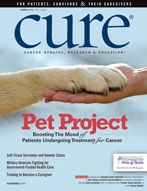Facing Skin Cancer Risk
Virginia nurses raised awareness about skin cancer risk by evaluating people’s faces for sun damage.
Virginia's humid, subtropical climate makes for beautiful weather and plenty of days to spend outside in the sun. As a result, however, Oncology Nursing Society (ONS) member Adrienne Banavage, a registered nurse and nursing education coordinator at the Emily Couric Cancer Center at the University of Virginia Health Systems in Charlottesville, noticed a serious need for skin cancer education among those in her community.
Knowing that many there are at risk, and having firsthand experience treating patients with skin cancer, Banavage and her colleagues decided to take action, and set to work creating a public education program to support those in their community.
“We have a fairly significant rate of skin cancer in central Virginia,” Banavage said. “There’s a moderate to high amount of agriculture here, so lots of people are outside all day.” Banavage also noted that, because Charlottesville is a college town, the message was in a prime space to impact the health of a younger generation by creating awareness around skin cancer.
In fact, skin cancer awareness is an important issue across the country for people of all ages. Basal and squamous cell skin cancers account for more than 5.4 million diagnoses each year, and the more potentially deadly melanoma accounts for more than 76,000, according to the American Cancer Society.
Thanks to help from the ONS Foundation and its Cancer Public Education Award, Banavage was able to lead a team of oncology nurses to create the campaign UVigilant: Illuminating Skin Cancer Prevention at the City Market. Their project was focused on creating awareness about the dangers of skin cancer and the importance of protection from ultraviolet (UV) light generated by the sun and other sources. Working with the Virginia Cancer Network (VCN), Banavage gathered a team of oncology nurses to set up a booth at the farmer’s market in Charlottesville, Virginia, and engage with local patrons over eight months.
Their partnership with VCN gave the nurses access to a UV exposure camera and printer. This gave participants a look at their own skin damage caused by UV rays. The camera, designed to be used by health care professionals to highlight skin damage, used side-by-side images of a person’s face under a regular camera lens and a UV camera lens. Photos were taken of the participants and printed out to use in consultation with their primary-care physicians.
“People were really enticed to participate when they learned about the UV camera,” Banavage said. “They were fascinated by the idea that they could get immediate feedback on what their skin damage was.”
Once the participants received their pictures, they were provided with educational materials that highlighted the proper ways to stay safe in the sun.
“Many were surprised that they had any skin damage at all, especially the younger people,” Banavage noted. Participants who said they regularly wore sunscreen and participated in behaviors to reduce skin damage were also surprised to see that they might not have been as thorough with their sunscreen as they had originally thought. “Typically, people don’t apply sunscreen as effectively as they could,” Banavage said. “That was a good talking point, as well.”
According to Banavage, the UVigilant program reached 344 participants (74 percent female and 26 percent male). Half of the participants were 18 to 35 years old, including some college students. Banavage reported that 41 percent of participants, prior to talking with her and her colleagues, stated that they always or nearly always used sun protection. After participants saw their pictures from the UV camera and were educated about the dangers of skin damage, 72 percent reported that they intended to increase their use of sun protection. Moreover, two-thirds of participants said that they would follow up with their family doctors regarding their risk for skin cancer; 58 percent said that they planned to have a skin cancer screening done by their doctor.
While screening for skin cancer is not needed by everyone with UV damage, there are signs that can indicate that a check by a doctor is a good idea. Signs and symptoms of skin cancers can include changes in the size or color of moles, growths or spots; the appearance of new skin growths; the presence of rough, scaly or oozing skin; one or more sores that won’t heal; coloring that spreads beyond the edge of a mole; or skin tenderness, pain or itchiness.
The team’s work didn’t stop with the UVigilant project: Banavage noted that she and her colleagues continue to host skin cancer-related educational events in the Charlottesville community. Hopefully, she added, other communities will take up this call to arms against skin cancer and provide their residents with opportunities to better understand skin cancer prevention.
Those who want to learn more about their risk for skin cancer can ask an oncology nurse or a dermatologist how to protect against UV damage, and for information about screening.
The Oncology Nursing Society Foundation is the only entity in the world that directly supports the projects of oncology nurses like Adrienne Banavage. Gifts to the foundation provide nurses who specialize in cancer care with access to education, research and professional development, ultimately improving patient care and advancing the oncology nursing profession. For more information about the foundation and ways to give, visit onsfoundation.org.
